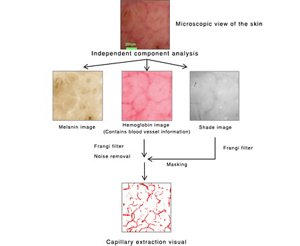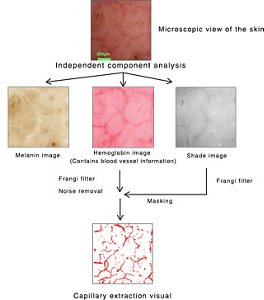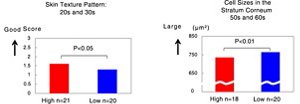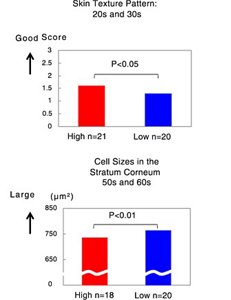Confirming the links between skin condition and regulation of capillary blood flow:
An image analysis technology to visualize capillaries in facial skin
This is an English translation of a news release in Japanese on August 2.
In the course of their dermatological research focusing on physical functions such as blood circulation, researchers at the Skincare Laboratory and Enterprise Information Solutions of Kao Corporation (Michitaka Sawada, President) have uncovered links between regulation of capillary blood flow and the condition of the skin.
To more closely examine the relationship between capillaries and skin, these researchers have also developed an image-processing technology capable of automatically discriminating capillaries in microscopic images of facial skin (Fig. 1).



Fig. 1: Image extraction algorithm for visualizing capillaries
This research was partially presented at the 58th Annual Conference of Japanese Society for Medical and Biological Engineering held in Okinawa Prefecture between June 6 and 8, 2019 and at the 19th Scientific Meeting of the Japanese Society for Anti-Aging Medicine held in Kanagawa Prefecture between June 14 and 16, 2019.
Background
Kao has been researching the relationship between skin condition and physical functions such as the blood circulation from a dermatological perspective as the skin is part of the whole body system. In 2015 this research led to the discovery that people with higher capacity to regulate blood flow in response to environmental changes tended to be people with less skin dryness. Vascular reactivity is reported to be linked to mental stress.*1 ,*2
Capillaries are fine blood vessels branching away from the veins and arteries throughout the body. They perform the most essential function in the circulatory system by exchanging materials between the blood and tissue cells, that is, supplying oxygen and nutrients to the tissue and removing waste matter from the tissue. The mechanism by which capillaries regulate blood flow differs from the veins and arteries. Specifically, the capillary blood flow is regulated by the oxygen concentration of the tissue and metabolic activity.
So far it has been impossible to precisely visualize and measure the extremely fine capillaries by discriminating them from the surrounding tissue. Much has yet to be learned about the relationship between the workings of the capillaries and the functions and metabolism of the skin and skin beauty.
-
* 1 Vascular reactivity, or the capacity to regulate the blood flow, is measured based on the thermoregulation of the skin. After immersing the hands in cold water at a temperature of 15°C for one minute, the hands are removed from the water and the temperature of the fingertip skin is immediately measured by thermographic images. The temperature of the fingertip skin is measured again ten minutes later to determine the rate of skin temperature recovery.
-
* 2 Kao News Release issued on July 30, 2015 entitled "Discovery of the relationship between blood vessel strength and the properties of the skin: Toward the stage of bio-beauty science through the fusion of dermatology and health science,"
https://www.kao.com/jp/corporate/news/2015/20150730_001/
Research I: The relationship between functions of the capillaries and skin conditions
In 2017 Kao researchers used a microscope to examine the capillaries in the skin of 98 Japanese women in their twenties to their sixties. The goal was to examine how the skin condition correlates with the blood flow regulatory function of the capillaries*3 or the area, length, and density of the capillaries in a resting state. The results revealed that the blood flow regulatory functions correlate with more parameters of skin conditions than the regular capillary condition.
-
* 3 Quantitative changes in the area of capillary blood vessels before - after the application of warm water (32℃) saturated with carbon dioxide in localized areas.
An analysis based on differences in age further revealed that women in their twenties and thirties with higher blood flow regulatory function tended to have better skin texture pattern. On the other hand, women in their fifties and sixties with higher blood flow regulatory function have smaller cell sizes in the stratum corneum*4 . This suggests epidermal cells were activated (Fig. 2).
-
* 4 Normally, delayed epidermal turnover induce larger cell size on aged skin.



Fig. 2: Relationship between skin conditions and blood flow regulation functions of the capillaries (generation-based analysis)
Research II: Development of imaging analysis technology for automatic visual extraction of capillaries in the skin
In order to examine the relationship between capillary blood vessels and skin condition in greater detail, Kao researchers developed an imaging technology to visually extract capillaries with high precision under a microscope.
The presence of melanin and hair in and on facial skin makes it difficult to measure capillaries by conventional imaging techniques. To solve this problem, images of the capillaries inside the skin can be divided into separate independent components of hemoglobin, melanin, and shade. Filter processing is then applied to the hemoglobin images to visually discriminate the capillaries based on their tubular structure. Masking is then performed using images generated from the shade component to attenuate the noise innate to hair. With this method, Kao researchers have constructed an algorithm for precisely discriminating the capillaries in microscopic images (Fig. 1).
To confirm the precision of this process, the algorithm was compared with conventional measurement by trained experts annotating the microscopic images of the capillaries manually. In this comparison, 96.6% of all the extracted images were in alignment with the annotated area. Capillaries in the skin were visually extracted with high precision in a matter of seconds.
Conclusion
Kao researchers found a connection between the blood flow regulatory function of the capillaries and skin conditions. This finding, coupled with earlier research, strongly suggests that blood flow regulatory function is linked to skin beauty. The development of a new evaluation method combining this visual discrimination algorithm and quantitative measurement of the capillaries from microscopic images of the skin will make it possible to assess the state and functions of capillaries and more fully investigate the links with facial skin.
In the future Kao researchers plan to study changes in the condition of the blood vessels brought about by aging and the environment and to analyze the effects on various phenomena such as skin metabolism, dark spots, and fine lines.
Media inquiries should be directed to:
Corporate Communications
Kao Corporation
